当前位置:网站首页>Detailed explanation and application of merging and sorting
Detailed explanation and application of merging and sorting
2022-07-02 23:03:00 【Joey Liao】
List of articles
Algorithm ideas
Let's just say that , All recursive algorithms , You don't care what it does , It's essentially traversing a tree ( recursive ) Trees , And then at the node ( Front, middle and rear positions ) Execute code on , You have to write recursive algorithms , In essence, it is to tell each node what to do .
Look at the code framework of merging and sorting :
// Definition : Sort nums[lo..hi]
void sort(int[] nums, int lo, int hi) {
if (lo == hi) {
return;
}
int mid = (lo + hi) / 2;
// Using definitions , Sort nums[lo..mid]
sort(nums, lo, mid);
// Using definitions , Sort nums[mid+1..hi]
sort(nums, mid + 1, hi);
/****** Post sequence position ******/
// At this point, the two molecular arrays have been ordered
// Merge two ordered arrays , send nums[lo..hi] Orderly
merge(nums, lo, mid, hi);
/*********************/
}
// Put an ordered array nums[lo..mid] And ordered arrays nums[mid+1..hi]
// Merge into an ordered array nums[lo..hi]
void merge(int[] nums, int lo, int mid, int hi);
Look at this frame , I understand the classic summary : Merge sort is to sort the left-hand array first , Then put the right half of the array in order , Then merge the two halves of the array .
The above code is very similar to the post order traversal of binary tree :
/* Binary tree traversal framework */
void traverse(TreeNode root) {
if (root == null) {
return;
}
traverse(root.left);
traverse(root.right);
/****** Post sequence position ******/
print(root.val);
/*********************/
}
above Binary tree ( Programme ) The binary tree problem can be divided into two kinds of ideas , One is the idea of traversing a binary tree , The other is the idea of decomposing the problem , According to the above analogy , Obviously, merging and sorting uses the idea of decomposing the problem
The process of merging and sorting can be logically abstracted into a binary tree , The value of each node in the tree can be considered as nums[lo..hi], The value of the leaf node is a single element in the array :
then , In the sequential position of each node ( The left and right child nodes have been arranged in order ) When it comes to execution merge function , Merge subarrays on two child nodes :
Code implementation and Analysis
《 Algorithm 4》 The merge sort code given in has the characteristics of simplicity and efficiency , So we can refer to the code given in the book as the merging algorithm template :
class Merge {
// Used to help merge ordered arrays
private static int[] temp;
public static void sort(int[] nums) {
// First open up memory space for the auxiliary array
temp = new int[nums.length];
// Sort entire array ( Modify in place )
sort(nums, 0, nums.length - 1);
}
// Definition : Sub array nums[lo..hi] Sort
private static void sort(int[] nums, int lo, int hi) {
if (lo == hi) {
// Individual elements do not need to be sorted
return;
}
// This is written to prevent overflow , The effect is equivalent to (hi + lo) / 2
int mid = lo + (hi - lo) / 2;
// First on the left half of the array nums[lo..mid] Sort
sort(nums, lo, mid);
// Then on the right half of the array nums[mid+1..hi] Sort
sort(nums, mid + 1, hi);
// Combine two parts of an ordered array into one
merge(nums, lo, mid, hi);
}
// take nums[lo..mid] and nums[mid+1..hi] The two ordered arrays are combined into an ordered array
private static void merge(int[] nums, int lo, int mid, int hi) {
// The first nums[lo..hi] Copy to auxiliary array
// So that the combined results can be directly stored in nums
for (int i = lo; i <= hi; i++) {
temp[i] = nums[i];
}
// Array double pointer technique , Merge two ordered arrays
int i = lo, j = mid + 1;
for (int p = lo; p <= hi; p++) {
if (i == mid + 1) {
// The left half of the array has been merged
nums[p] = temp[j++];
} else if (j == hi + 1) {
// The right half of the array has been merged
nums[p] = temp[i++];
} else if (temp[i] > temp[j]) {
nums[p] = temp[j++];
} else {
nums[p] = temp[i++];
}
}
}
}
With the foreshadowing , Here we just need to focus on this merge function .
sort Function pair nums[lo..mid] and nums[mid+1..hi] After recursive sorting , We can't merge them in place , So we need to copy To temp In an array , And then through something similar to the above Six skills of single linked list The double pointer technique of merging ordered linked lists in nums[lo..hi] Merge into an ordered array :
Notice that we're not merge Function execution time new Auxiliary array , It's about putting... In advance temp Auxiliary array new Come out , So you It avoids the possible performance problems caused by frequent allocation and release of memory in recursion .
Again, the time complexity of merging and sorting , Although everyone should know that O(NlogN), But not everyone knows how to calculate this complexity .
above Dynamic planning details Said the complexity calculation of recursive algorithm , Namely Number of sub questions x The complexity of solving a subproblem . For merge sort , The time complexity is obviously concentrated in merge Ergodic function nums[lo..hi] The process of , But every time merge Input lo and hi All different , Therefore, it is not easy to see the time complexity intuitively .
 The number of execution times is the number of binary tree nodes , The complexity of each execution is the length of the subarray represented by each node , So the total time complexity is in the whole tree 「 Array elements 」 The number of .
The number of execution times is the number of binary tree nodes , The complexity of each execution is the length of the subarray represented by each node , So the total time complexity is in the whole tree 「 Array elements 」 The number of .
So on the whole , The height of this binary tree is logN, The number of elements in each layer is the length of the original array N, So the total time complexity is O(NlogN).
Other applications
In addition to the most basic sorting problem , Merging and sorting can also be used to solve the problem of force deduction 315 topic 「 Count the number of elements on the right less than the current one 」: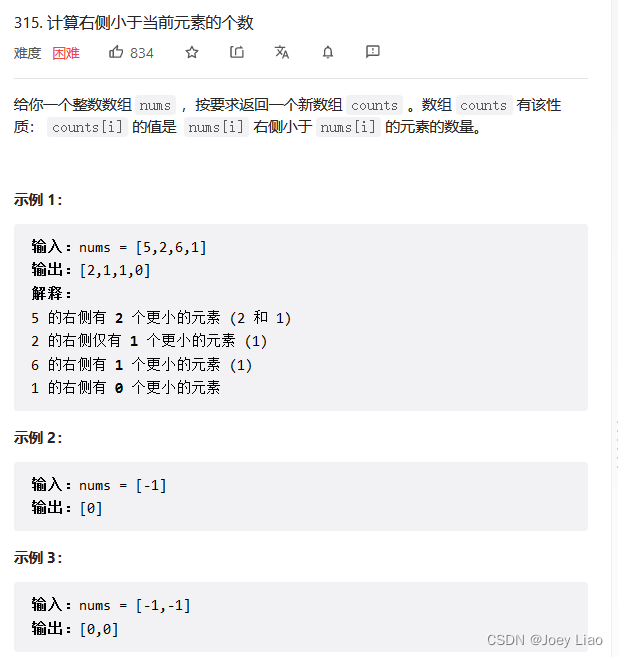
Let's not talk about the violent solution of patting our heads , nesting for loop , Square level complexity .
What does this question have to do with merging and sorting , Mainly in the merge function , We are using merge Function when merging two ordered arrays , In fact, you can know an element nums[i] How many elements are there behind nums[i] Small .
say concretely , For example, this scene :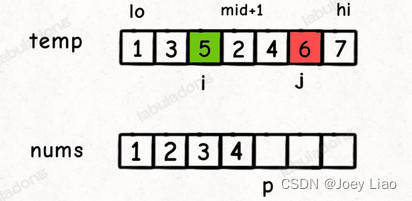
At this time, we should put temp[i] Put it in nums[p] On , because temp[i] < temp[j].
But in this scenario , We can also know a message :5 Rear ratio 5 The small number of elements is Left closed right open interval [mid + 1, j) The number of elements in , namely 2 and 4 These two elements :
let me put it another way , In the face of nuns[lo..hi] In the process of merging , Whenever executed nums[p] = temp[i] when , You can be sure temp[i] The number of elements smaller than this element is j - mid - 1.
Of course ,nums[lo..hi] Itself is just a sub array , This subarray will be executed later merge, Of the elements The position will still change . But this is a problem that other recursive nodes need to consider , All we have to do is merge Do some tricks in the function , Stack each time merge The results recorded at .
class Solution {
private class Pair {
int val, id;
Pair(int val, int id) {
// Record the element value of the array
this.val = val;
// Record the original index of the element in the array
this.id = id;
}
}
// Auxiliary array used for merging and sorting
private Pair[] temp;
// Record the number of elements smaller than yourself after each element
private int[] count;
// The main function
public List<Integer> countSmaller(int[] nums) {
int n = nums.length;
count = new int[n];
temp = new Pair[n];
Pair[] arr = new Pair[n];
// Record the original index position of the element , In order to be in count Update the result in the array
for (int i = 0; i < n; i++)
arr[i] = new Pair(nums[i], i);
// Perform merge sort , The result of this question is recorded in count Array
sort(arr, 0, n - 1);
List<Integer> res = new LinkedList<>();
for (int c : count) res.add(c);
return res;
}
// Merge sort
private void sort(Pair[] arr, int lo, int hi) {
if (lo == hi) return;
int mid = lo + (hi - lo) / 2;
sort(arr, lo, mid);
sort(arr, mid + 1, hi);
merge(arr, lo, mid, hi);
}
// Merge two ordered arrays
private void merge(Pair[] arr, int lo, int mid, int hi) {
for (int i = lo; i <= hi; i++) {
temp[i] = arr[i];
}
int i = lo, j = mid + 1;
for (int p = lo; p <= hi; p++) {
if (i == mid + 1) {
arr[p] = temp[j++];
} else if (j == hi + 1) {
arr[p] = temp[i++];
// to update count Array
count[arr[p].id] += j - mid - 1;
} else if (temp[i].val > temp[j].val) {
arr[p] = temp[j++];
} else {
arr[p] = temp[i++];
// to update count Array
count[arr[p].id] += j - mid - 1;
}
}
}
}
Because in the sorting process , The index position of each element will change constantly , So we use a Pair Class encapsulates each element and its in the original array nums Index in , In order to count Array records the number of elements less than it after each element .
Flip it right
Take a look at the force buckle 493 topic 「 Flip it right 」
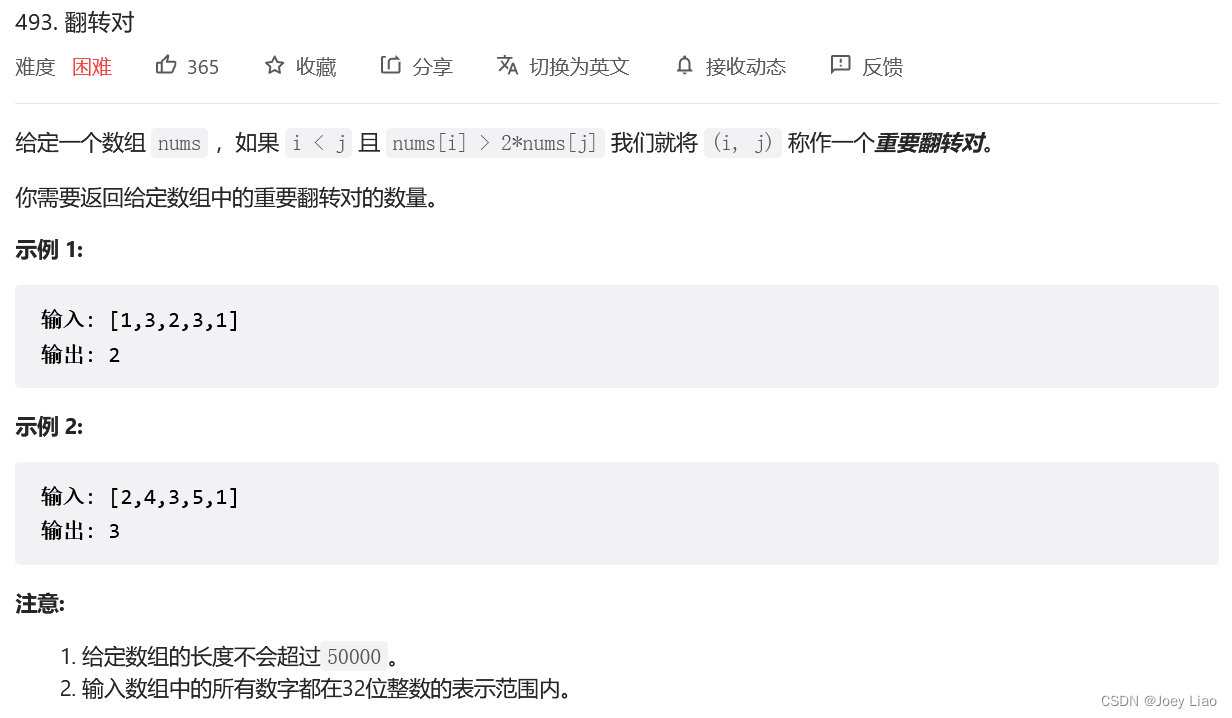
So of course, the idea of solving problems still needs to be merge Do something in the function , When nums[lo..mid] and nums[mid+1..hi] After sorting the two subarrays , about nums[lo..mid] Every element in nums[i], Go to nums[mid+1..hi] Look for qualified nums[j] That's it .
The code is as follows :
class Solution {
int res=0;
int[] temp;//,doubleTemp;
public int reversePairs(int[] nums) {
int n=nums.length;
temp=new int[n];
mergeSort(nums,0,n-1);
return res;
}
public void mergeSort(int[] nums,int left,int right){
if(left==right){
return;
}
int mid=left+(right-left)/2;
mergeSort(nums,left,mid);
mergeSort(nums,mid+1,right);
merge(nums,left,mid,right);
}
public void merge(int[] nums,int left,int mid,int right){
for(int i=left;i<=right;i++){
temp[i]=nums[i];
}
************************************************* The difference from ordinary merge sorting is here
int end=mid+1;
for(int i=left;i<=mid;i++){
while(end<=right&&(long)nums[i]>(long)nums[end]*2){
end++;
}
res+=end-(mid+1);
}
************************************************
int i=left,j=mid+1;
for(int k=left;k<=right;k++){
if(i==mid+1){
nums[k]=temp[j++];
}else if(j==right+1){
nums[k]=temp[i++];
}else if(temp[i]<temp[j]){
nums[k]=temp[i++];
}else{
nums[k]=temp[j++];
}
}
}
}
The number of interval sums
Finally, let's look at a more difficult topic , Force to buckle 327 topic 「 The number of interval sums 」:
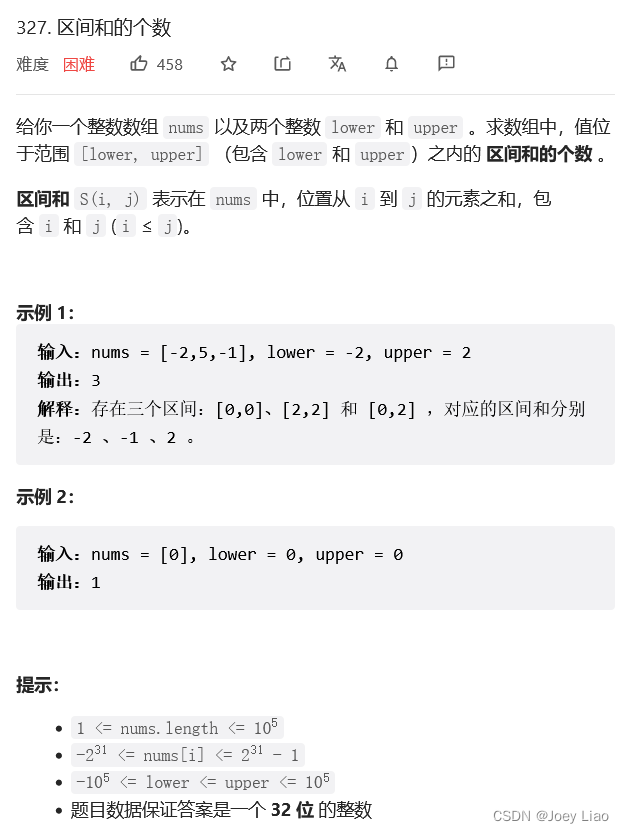
In short , The title lets you calculate the elements and fall on [lower, upper] The number of all subarrays in .
I won't talk about the violent solution of patting my head , Still nested for loop , Here we still talk about the efficient algorithm realized by merging and sorting .
First , To solve this problem, we need to quickly calculate the sum of subarrays , You need to create a prefix and array preSum To help us quickly calculate the interval sum .
I will continue to express this problem in the language of comparative Mathematics , The title lets you pass preSum Find an array count Array , bring :
count[i] = COUNT(j) where lower <= preSum[j] - preSum[i] <= upper
Then please work out this count The sum of all elements in the array .
private int lower, upper;
public int countRangeSum(int[] nums, int lower, int upper) {
this.lower = lower;
this.upper = upper;
// Build prefixes and arrays , Be careful int It may spill over , use long Storage
long[] preSum = new long[nums.length + 1];
for (int i = 0; i < nums.length; i++) {
preSum[i + 1] = (long)nums[i] + preSum[i];
}
// Merge and sort prefixes and arrays
sort(preSum);
return count;
}
private long[] temp;
public void sort(long[] nums) {
temp = new long[nums.length];
sort(nums, 0, nums.length - 1);
}
private void sort(long[] nums, int lo, int hi) {
if (lo == hi) {
return;
}
int mid = lo + (hi - lo) / 2;
sort(nums, lo, mid);
sort(nums, mid + 1, hi);
merge(nums, lo, mid, hi);
}
private int count = 0;
private void merge(long[] nums, int lo, int mid, int hi) {
for (int i = lo; i <= hi; i++) {
temp[i] = nums[i];
}
// Add some private goods before merging ordered arrays ( This code will time out )
// for (int i = lo; i <= mid; i++) {
// for (int j = mid + 1; j <= hi; k++) {
// // Look for qualified nums[j]
// long delta = nums[j] - nums[i];
// if (delta <= upper && delta >= lower) {
// count++;
// }
// }
// }
// Optimize efficiency
// Maintain the left closed right open section [start, end) The elements in and nums[i] What's the difference [lower, upper] in
int start = mid + 1, end = mid + 1;
for (int i = lo; i <= mid; i++) {
// If nums[i] The corresponding interval is [start, end),
// that nums[i+1] The corresponding interval must move to the right as a whole , Similar to sliding window
while (start <= hi && nums[start] - nums[i] < lower) {
start++;
}
while (end <= hi && nums[end] - nums[i] <= upper) {
end++;
}
count += end - start;
}
// Array double pointer technique , Merge two ordered arrays
int i = lo, j = mid + 1;
for (int p = lo; p <= hi; p++) {
if (i == mid + 1) {
nums[p] = temp[j++];
} else if (j == hi + 1) {
nums[p] = temp[i++];
} else if (temp[i] > temp[j]) {
nums[p] = temp[j++];
} else {
nums[p] = temp[i++];
}
}
}
We are still merge The function adds some logic before merging ordered arrays , If you read the above Sliding window core frame , This efficiency optimization is a bit like maintaining a sliding window , Let the elements in the window and nums[i] The difference between [lower, upper] in .
For example, the merging sorting algorithm mentioned in this paper , Recursive sort Function is the traversal function of binary tree , and merge Functions are what you do on each node , Have you tasted something ?
边栏推荐
- ServletContext learning diary 1
- [chestnut sugar GIS] ArcMap - why should the tick of classic capture be removed when using custom capture?
- Go 4 modes Singleton
- Higher order operation of bits
- go 条件变量
- 2016. 增量元素之间的最大差值
- 設置單擊右鍵可以選擇用VS Code打開文件
- psnr,ssim,rmse三个指标的定量分析
- 【硬件】标准阻值的由来
- MySQL queries nearby data And sort by distance
猜你喜欢

Go language sqlx library operation SQLite3 database addition, deletion, modification and query
![[leetcode] most elements [169]](/img/72/d3e46a820796a48b458cd2d0a18f8f.png)
[leetcode] most elements [169]

容器化技术在嵌入式领域的应用

【板栗糖GIS】arcmap—如何批量修改注记要素的字体,颜色,大小等

MySQL reset password, forget password, reset root password, reset MySQL password
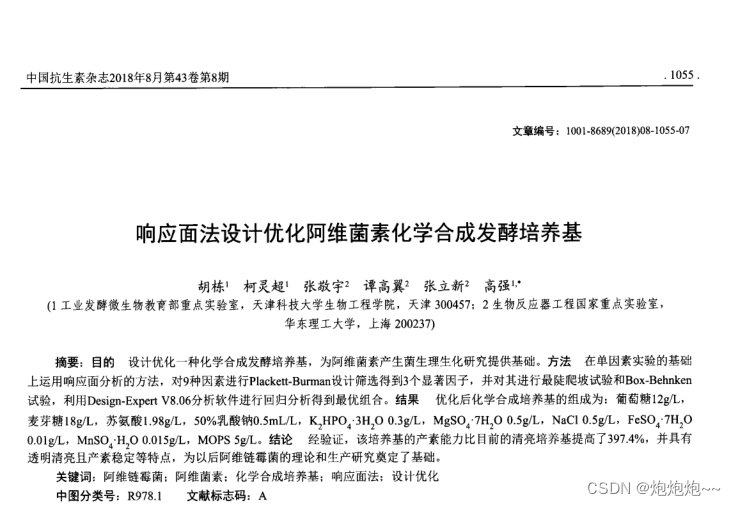
Learning records of data analysis (II) -- simple use of response surface method and design expert

Construction of Hisilicon 3559 universal platform: draw a frame on the captured YUV image

Methods to solve the tampering of Chrome browser and edeg browser homepage

QT qsplitter splitter

解决Chrome浏览器和Edeg浏览器主页被篡改的方法
随机推荐
[Solved] Splunk: Cannot get username when all users are selected“
Qt QScrollArea
`Usage of ${}`
[chestnut sugar GIS] how does global mapper batch produce ground contour lines through DSM
Jerry's fast touch does not respond [chapter]
移动端 1px 像素兼容性问题,实现1px 边框
严守工期,确保质量,这家AI数据标注公司做到了!
Comprehensively analyze the logic of the shared purchase business model? How sharing purchase empowers Enterprises
Construction of Hisilicon 3559 universal platform: draw a frame on the captured YUV image
數據分析學習記錄--用EXCEL完成簡單的單因素方差分析
Value sequence < detailed explanation of daily question >
Freshman learning sharing
World Environment Day | Chow Tai Fook serves wholeheartedly to promote carbon reduction and environmental protection
Stop slave is stuck -- the event of the transaction is not copied completely
go 条件变量
大一学习分享
景联文科技低价策略帮助AI企业降低模型训练成本
Odoo13 build a hospital HRP environment (detailed steps)
Jatpack------LiveData
E-commerce system microservice architecture